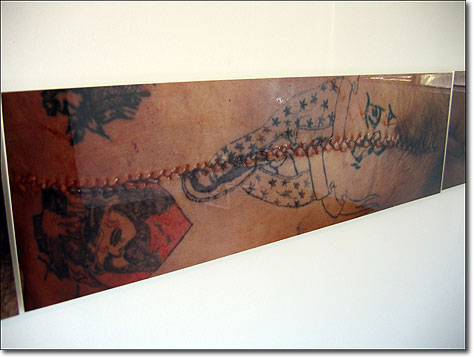Estación Tijuana ,
Aug 27, 2005 - Sep 25, 2005
Tijuana, Mexico
Touch of Evil at Estación Tijuana
by Rubén Bonet
The other video, Letters to an Army of Three (55 min) by Andrea Bowers, is also a documentary, though it exhibits more of an aesthetic base and is of a marked activist character. It deals with the letters (32) received by three feminists who helped pregnant women find safety - Canada, Japan and Tijuana - to obtain abortions in 1968 when they were illegal in the United States. Different actors fade in and out and read the correspondence in front of a new background complete with floral arrangement, having the kitsch aesthetic of a doctor’s office. The letters were written by students, poor workers who couldn’t afford to lose their jobs, mature mothers of several children, and fathers seeking advice. There was also one from a gynecologist who urged extreme discretion. The piece is rounded out with a packet of psychedelic posters featuring pastel-colored circles of oranges and pinks, simulating unused condoms that the public could take with them. In one of the circles is written: Keep your laws off my body.
Daniel J. Martinez participated with texts of a subversive nature, anti-manifestos of the hackneyed vanguard and counterculture, printed in vinyl on cloth inside of the space, and directly on the exterior walls. The following was written on the wall of the parking lot: "The nineteenth century dislike of realism is the rage of Caliban seeing his own face in the mirror", a reflection that alludes to Shakespeare’s The Tempest and to the19th century reception of realism, and which may be interpreted as a critique of those (U.S.A?) who reject the "reality" of the "other", when, in most cases, that otherness is firmly ensconced in the bosom of society itself. On the façade could be read: "We are all Baader-Meinhoff", a terrorist group active during the seventies. The piece by Sam Durant, A Partial Telling, is an unusual historical document. A projection of 35 mm (b/w) plates from the era when Tijuana was taken by Magonista anarchists, who were later evidently ousted. This chapter of history is not often publicized. Images were taken from books--the extensive bibliography was included in the technical file--where historic characters and events are shown annotated in footnotes: the brothers Flores Magón; The Main Street - later Avenida Revolución - where there are no more than two sheds on either side of the street; the customs house, another shed, taken by the Magonistas; covers from the International Worker of 1912; images of San Diegans lined up on the border observing the battle as if it were a sporting event, watching Tijuana burn, and, later, the images of the defeat, exile, and the prison camps. The hidden history of a movement that opposed the regime of dictator Porfirio Díaz and that would subsequently give birth to the PRI (the political party that monopolized Mexican politics for 70 years until 2000).
Last but not least, Rigo 23 presented an installation, Pastando (grazing) Side-by-Side with Danger, that included handicrafts normally sold to tourists. In this case, some little donkeys painted to look like zebras pulling a cart, in an allusion to the painted donkeys of Avenida Revolución, that are popular with tourists as a souvenir photo opportunity. One of the carts has flowers, the other fireworks.
In the context of the curatorial hypersaturation that inSITE represents, Estación Tijuana’s proposal to invite artists to show the piece they thought fitting - as a matter of fact the majority were produced expressly for the event - sets a precedent of creative freedom and the possibility of the articulation of a more flexible and fluid dialogue where the totality of the interpretation is completed with different, apparently unconnected, subjective interpretations.
This exhibition, held in one of the few independent exhibition spaces in Tijuana (the other is managed by Tania Candiani, where on the same day she held the inauguration of Takatrama, a pictorial exhibition by F. Fernandez, el taka), comprises a critical and precise vision of the border condition, its historical antecedents and its possibilities for representation.
|













